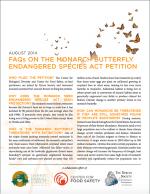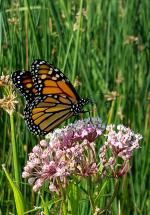As a science-based organization, the Xerces Society produces dozens of publications annually, all of which employ the best available research to guide effective conservation efforts. Our publications range from guidelines for land managers, to brochures offering overviews of key concepts related to invertebrate conservation, from books about supporting pollinators in farmland, to region-specific plant lists. We hope that whatever you are seeking—whether it's guidance on making a home or community garden pollinator-friendly, advice on developing a local pesticide reduction strategy, or detailed information on restoring habitat—you will find it here!
Find Publications
Use the search functions to sort by publication type (books, guidelines, fact sheets, etc.), location, and/or subject (agriculture, gardens, pollinators, pesticides, etc.).
On behalf of the Xerces Society for Invertebrate Conservation and the Natural Resources Defense Council ("NRDC"), we are writing to inform you that we intend to pursue legal action against the U.S. Department of the Interior, the U.S. Fish and Wildlife Service, and agency officials acting in their official capacities for failure to respond to a petition to list the rusty patched bumble bee (Bombus affinis) as an endangered species pursuant to the Endangered Species Act ("ESA"), 16 U.S.C. § 153 1, et seq.
In light of the severe decline of both the eastern and western monarch butterfly populations that has occurred since the late‐1990s, we are writing to ask you to establish a multi‐agency monarch butterfly recovery initiative to restore the habitats that support the extraordinary migrations of this iconic species. We encourage you to direct the Natural Resources Conservation Service (NRCS), Farm Service Agency (FSA), and Forest Service (USFS) of the U.S. Department of Agriculture and the Fish and Wildlife Service (USFWS) and Bureau of Land Management (BLM) of the U.S. Department of the Interior to develop a cooperative, landscape‐level initiative with the many stakeholders willing to help foster significant monarch recovery.
This 3-page fact sheet provides answers to commonly asked questions regarding the Petition to list the monarch butterfly as Threatened under the Endangered Species Act.
We write to you to express our support to protect the monarch butterfly as a Threatened species under the Endangered Species Act (ESA). The monarch butterfly population has declined dramatically, by an alarming, statistically significant 90% over 20 years of monitoring. While many factors threaten the monarch’s habitat, it is the loss of milkweed from the key areas where monarchs breed in the American Midwest— primarily driven by extensive use of the herbicide glyphosate on genetically engineered glyphosate-resistant crops—that is thought to be the most significant contributor to the monarch’s population decline. Other contributing factors may include climate change, severe weather events, logging in the overwintering habitat, wide spread use of systemic insecticides, disease, and predation.
The undersigned companies and organizations write to you to express support for that legal petition and protecting the monarch butterfly as a threatened species under the ESA. The North American monarch butterfly population has declined by 90 percent in the past 20 years, dropping from a high of approximately 1 billion butterflies in the mid-1990s to less than 35 million butterflies last winter – the lowest number ever recorded.
Our comments cite recent research and provide additional evidence to support the following factors outlined in our 2013 petition. In addition, we provide updated information about this species’ current range and conservation status, including a recently published IUCN Red List extinction risk assessment for the rusty patched bumble bee, in which the species was listed as Critically Endangered.
The Xerces Society for Invertebrate Conservation hereby formally petitions to list the rusty patched bumble bee (Bombus affinis) as an endangered species under the Endangered Species Act, 16 U.S.C. § 1531 et seq. This petition is filed under 5 U.S.C. 553(e) and 50 CFR 424.14(a), which grants interested parties the right to petition for issue of a rule from the Secretary of the Interior.
Bee Case Complaint as filed
More than a year has elapsed since Xerces Society filed its January 31, 2013, petition for listing (the “Petition”), and Defendants have not yet issued a ninety-day finding. Defendants’ inaction thwarts a collective commitment— manifest in the ESA itself—to our country’s most imperiled species and risks the irretrievable loss of the rusty patched bumble bee from the wild forever.
Strengthen neonicotinoid product labels by expanding and clarifying pollinator warning language
This fact sheet for growers provides information and resources to encourage nurseries to grow native milkweed.









